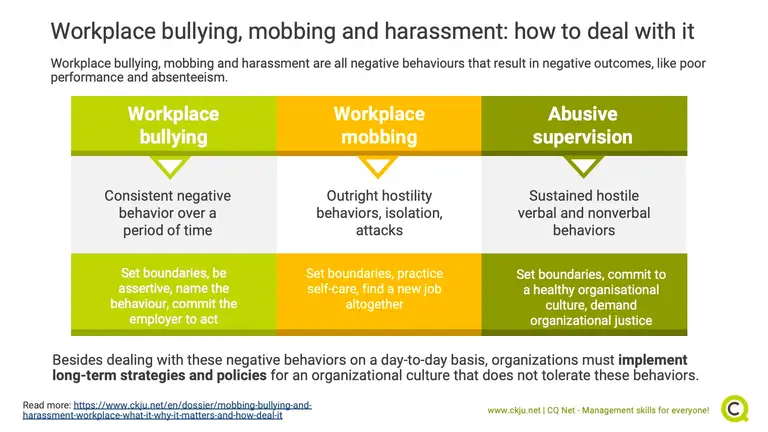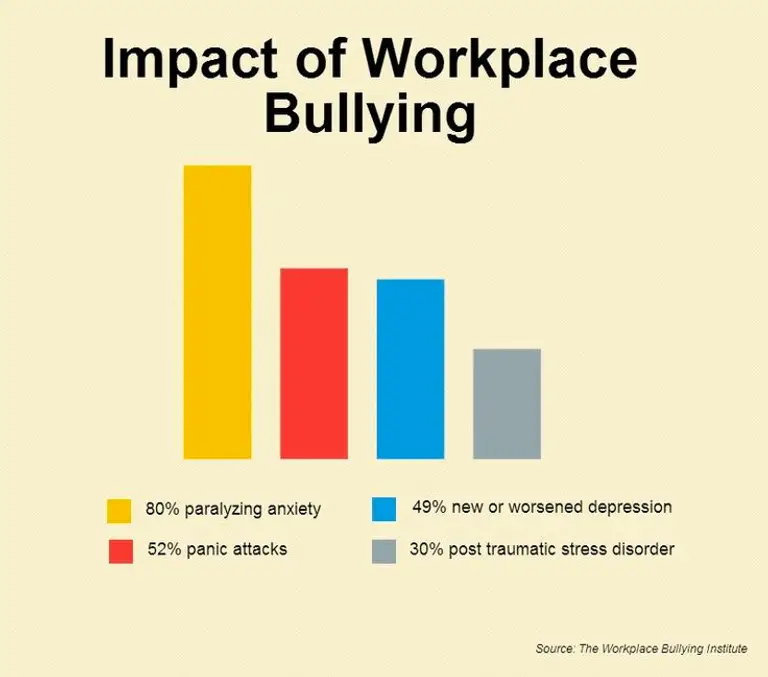The way we work has evolved significantly in the past decades. However, with all the good changes, some bad things have emerged too. Primarily, workplace bullying or mobbing.
Often, mobbing victims feel like they can't escape the harassment, and they may feel like they are stuck in an environment that is hostile and dangerous. It occurs when individuals in a group target and harass one another.
Today, we're going to show the effects of mobbing, define what mobbing is, and how to prevent this type of toxic work environment.
Key Takeaways
- Mobbing in the workplace involves a group of individuals targeting and harassing a colleague, which can create a hostile and dangerous environment.
- Understanding the impact of mobbing is crucial for fostering a positive work environment; it requires recognizing the patterns and reasons behind such behaviors.
- Effective strategies to prevent mobbing include clear communication of job roles, promoting a culture of respect, and implementing strong anti-harassment policies.
- Key signs of mobbing include scapegoating, isolation, humiliation, and intimidation, which can lead to significant emotional and psychological distress for the victim.
- Handling mobbing involves documenting incidents, providing support to victims, and involving HR and management to address and resolve the issues effectively.

What is mobbing in the workplace?
Mobbing amounts to harassment in the workplace. It is defined as a series of events or behaviors that make work difficult or threatening for an individual. It's usually a group of people getting together to target and harass an individual.

These people disturb the status quo and harass others on different basis, such as sexual orientation, religion, age and other.
How to deal with mobbing at work? Companies usually make use of online work schedules to make sure a safe work environment is provided to all employees.
The difference between mobbing and bullying
A bully works alone, while a mob could be a whole lot of people coming together for the same malicious intent.
The bully usually tries to find a position of strength to harass the victim, whereas mobbing usually takes place wherever the victim is found.
Workplace bullying typically involves physical violence or intimidation, whereas mobs use threats and behaviors to create an abnormal atmosphere for the victim.

Why does mobbing happen in the workplace?
To create a positive work environment that has no verbal aggression and emotional abuse, you first need to understand why it happens.
- One reason is that it can be a way for people to vent their anger and frustration on a victim of mobbing.
- Another reason is that it can be a way for people to feel like they are in control.
- Mobbing can also occur when an employee is perceived to be a threat to the company or to other employees for a certain period of time.
- And finally, mobbing can be a way for people to make their colleagues feel uncomfortable or intimidated.
Ten signs of mobbing at work
Mobbing is an emerging term that describes a pattern of bullying and harassment in the workplace. Some mobbing at work examples include:
1. Cycle of abuse
This happens when one individual repeatedly behaves aggressively towards another, with the aim of creating a sense of fear and insecurity through different forms of workplace bullying.
It is important to be aware of the signs of mobbing so that you can take steps to protect yourself and reduce stress at your workplace. When the negative behavior keeps happening for an extended period of time, it may be too late to save the situation.
2. Scapegoating
When someone is scapegoated, they are unfairly blamed for something that they did not do. This can happen in the workplace, where someone is blamed for a mistake that was not their fault, or it can happen in a group setting, where one person is blamed for the group's failure.
The fear of retaliation can keep this form of psychological terror and emotional abuse going for long periods of time.
Either way, scapegoating is a form of bullying, and it can have a very negative impact on the person who is being scapegoated. If you are being scapegoated at work, it is important to speak up and let your boss or co-workers know that you are not to blame.
3. Isolation
Victims are often left alone and feel isolated, which can lead to feelings of anxiety and depression. Isolation can include being isolated from work tasks and social interactions, as well as being subjected to malicious rumors and gossip. Even when verbal abuse does not happen, hostile behavior can still be present.
Isolation can lead to feelings of anxiety, depression, and isolation, and can have a significant impact on an individual's work performance and mental health.
If you are experiencing isolation at work, seek support from a trusted friend or family member, and speak to your employer about the situation. This is not acceptable behavior by any means and should be punished with disciplinary action.
4. Humiliation
Humiliation is a sign of workplace mobbing and emotional abuse. It is a form of bullying that targets an individual and seeks to undermine their self-confidence and self-esteem.
Humiliation can take many forms, such as being belittled or ridiculed in front of others, being passed over for promotions, or being given tasks that are below your skill level.
Speak to your line manager, HR, or a trade union representative, who'll know how to stop mobbing at work and show you how to take legal action.
5. Intimidation
Intimidation is common but a bit difficult to identify in the workplace. Intimidation can take many forms, from overt threats and aggression to more subtle forms of coercion and manipulation and other mobbing activities.
Try to take note of the pattern you see and try to document this toxic behavior. This can be difficult to do on your own, so it may be helpful to speak to a trusted colleague or supervisor about your concerns. They can help document the mobbing process and protect you at the same time.
6. Power dynamics
The power dynamics in any workplace can be a sign of potential mobbing behavior. If there is a clear hierarchy in place and people in positions of power are constantly putting others down or making them feel uncomfortable, it can create a breeding ground for a mobbing process.
If you see power dynamics at play in your workplace, take all necessary steps to prevent it from happening. It may look naive at first, but it can turn into a form of collective bullying that stunts employee performance across your organization.
7. Use of violence
A violent mob usually succeeds in trying to intimidate and scare the victim. There are many mobbing techniques and unfortunately, the use of physical violence happens too.
This can lead to a hostile work environment and can ultimately result in the mobbing targets being forced to leave their job. It's best to talk to a professional about workplace mobbing in such cases.
8. Bullying
Bullying is a form of workplace harassment. Bullying and workplace mobbing are characterized by repeated and persistent attacks on an individual, often by a group of co-workers. This can have a serious impact on an individual's health. Speak up and get help.
9. Manipulation
Mobbing often involves using the victim's vulnerabilities to manipulate them into doing what the attacker wants.
This is a way for the aggressor to control and intimidate the victim. This type of behavior is often used to make the victim feel powerless and isolated. It is important to recognize the signs and take action to protect yourself.
10. Sexual harassment
Sexual harassment is a form of bullying that targets an individual because of their gender. This can take many different forms, from unwanted sexual advances to lewd comments and sexually explicit jokes.
Your employer has a responsibility to create a safe and respectful workplace, and they can take steps to address the problem. This can be physical abuse or psychological harassment that can and should be taken to human resources.
How to handle workplace mobbing?
You must know how to report mobbing at work.
- First, know your rights. You have the right to be treated with respect, and to be free from harassment and mobbing activites. Talk to your supervisor or HR representative about what is happening. This will prompt them to manage your leave to reduce your constant exposure to mobbing tactics.
- Keep a record of the incidents. This will help you to remember what happened and to document any patterns or behavior that seem to be contributing to the mobbing.
- Do not let the mobbing intimidate you. There may be other people at your workplace suffering from a similar situation. There are resources available to you, including support groups and counseling.
- If you feel you are in danger, you can try to get away. If you feel that you cannot escape, try to create a protective barrier between yourself and the mob. You can try to shout or scream to get the attention of the mob, or use your phone to dial for help.
When you feel you're being excluded from work activities, being given impossible tasks, or being subject to false rumors or gossip, get help. If the behavior is severe, you may decide to seek legal counsel.
Learn More
Interested in enhancing workplace culture? Find out how with our extensive resources on Work Environment and Culture.
- Hybrid culture in the modern world environments are the future. Find out how to blend remote and in-office work seamlessly.
- See the impact of allowing self-scheduling on productivity and employee empowerment.
- Learn to identify the critical warning signs with our guide on signs of poor management.
- How can you ensure your team achieves a good work-life balance? Implement our work-life balance initiatives that work.
- 43% of managers struggle with micromanagement. Learn how to avoid common pitfalls in our comprehensive guide on micromanagement.
- Tackle negativity at work head-on with strategies that promote a positive and inclusive workplace.
Wrapping up
If you're a target of workplace mobbing, it's imperative to speak up and talk to your company management. The sooner you talk to someone and get help, the sooner the mobbing activities and bullying behavior stop.
And if you run a business and want to get rid of workplace bullies, make sure to run a workplace bullying survey every now and then. When necessary, have a mental health professional talk to your employees and find out if you can make some improvements to benefit the employee morale.





